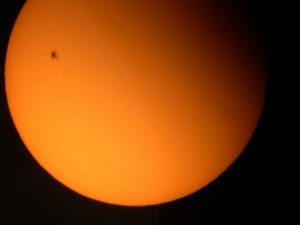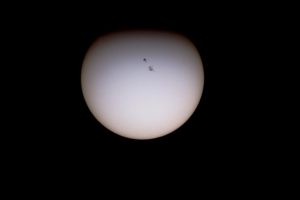by Sandor Geresdi
“When the Sun gets angry, a storm bird emerges: an enormous sunspot occurs, exceeding the size of the Earth multiple times.”

Ancient cultures worshiped the Sun as a god. They considered it a pure, life-giving force – just like we do today – and believed it to be flawless, with no possible imperfections.
In the ancient and medieval times, those who observed the Sun setting or rising on the horizon were convinced that the tiny spots they sometimes saw were silhouettes of birds. They strongly believed them to be eagles, wild ducks, and vultures with their wings spread. For long, people considered this to be true and thought that the small spots and dark, irregular smears appearing on the Sun time and time again were flocks of birds.
A few centuries ago, this belief changed in an instant and the birds ‘disappeared’. Astronomers and scientific explorers observing the Sun now possessed telescopes and opened humanity’s eyes to the truth: mankind had to realize that our Sun, with its spots, is actually a star among many.
Our Sun, with billions of other stars, has it own lifespan and goes through its own stages of life – just like the trees of the forest or the people of the Earth that are of different ages. The Sun had a birth and youth, it has its adulthood, and it will have a death. The current adult life of the Sun is accompanied by intense solar activity.
The tempestuous solar storms and the appearance of sunspots are related. Sunspots indicate intense magnetic activity. They are areas of reduced surface temperature caused by concentrations of magnetic disturbance. It has been observed that solar flares and coronal mass ejections originate in magnetically active regions around visible sunspots.
Individual sunspots may endure anywhere from a few days to a few months, but eventually decay. Sunspots expand and contract as they move across the surface of the Sun with sizes ranging from 10 miles to 100,000 miles in diameter. Sunspots usually appear in pairs and often show up over and over again with the Sun’s 27-day rotation, smaller and smaller until their decay.

Sunspot activity cycles about every eleven years characterized by a multitude of occurrences and intensity. This is called the solar cycle. This process is part of the Sun’s current and stabile stage of life – which is the longest phase, lasting approximately 6 billion years.
Solar cycles seem to have a powerful effect on the Earth. During solar maximum, large numbers of sunspots appear and the increased energy output can impact Earth’s global climate, as well as the electrical and communications systems. Enormous sunspots, multiple times larger than our planet may become visible and cause electromagnetic storms that can reach the Earth.
The electrically charged particles released from the Sun that enter the Earth’s atmosphere collide with gases such as oxygen and nitrogen, creating a colorful light show called the aurora or polar light. Seen around the northern (aurora borealis) and southern (aurora australis) poles, this incredible phenomenon is like a dramatic symphony played on an organ of lights.
We are currently experiencing a ‘quiet’ period. Forecasters are not anticipating any major bursts of activity in the next few years. But we don’t know how intense the next cycle of sunspots could be and how big the electromagnetic storms will get. We do know, however, that the effects of these storms can threaten our radio transmissions, telephone network, electrical grid, the internet, IT systems, and satellite communications.
The Earth has seen and survived many celestial events. For millennia people have laid their heads to rest at night without fearing the death of the Sun or concerns about sunspots and solar flares. But our Sun – just like a god – has an unpredictable nature, and we can’t with certainty know when it will send a glob of solar matter streaming towards the Earth next.
NOTE: Since looking directly at the Sun with the naked eye permanently damages human vision, amateur observation of sunspots can be conducted using projected images, or directly through protective filters. A very dark filter glass, such as a #14 welder’s glass or specialty filters on the front of a telescope can provide safe and effective observation of sunspots.
